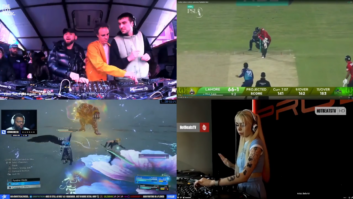
Creating and transmitting high-quality video content on the fly – for live display and online streaming – is increasingly important for a learned society such as the Royal College of Physicians. We report on the equipment that its AV team uses on a daily basis to achieve this.
The Royal College of Physicians (RCP), the professional membership body for more than 33,000 physicians across the globe, is based in an award-winning conference and events centre in the heart of London. The unique Grade I-listed building, with a capacity of up to 400, boasts a wide range of purpose-built facilities including auditoriums, meeting rooms and dining areas.
The building’s flexible and functional architecture is matched by its state-of-the-art AV systems, designed and installed by the RCP’s audiovisual, technical and media services (AVTMS) team, led by Ben Pain. “Here at the AVTMS we have a widely varied remit, as we not only support the audiovisual needs of our internal departments, but we also support external clients that hire the venue,” explains Pain. “We support all of the RCP’s live events, including conferences, lectures and dinners, which means providing lighting, sound, video, projection and interactive technologies, so it’s an extremely hectic and busy role.”
Medical advances
One of the main aims of the RCP is to drive improvements to clinical and patient care by ensuring members are up to speed on the latest in medical advances. According to Pain, the aim of keeping colleagues up to date is also a key challenge for his team.
“When you take into account advances in AV technologies over the past few years, as well as the high expectations of clients, there is a lot we have to keep abreast of to ensure our users can cost-effectively produce high-quality content,” he explains. “As the technology becomes increasingly more accessible, we now place a much greater emphasis on the value of our expertise and knowledge.” Video equipment from Blackmagic Design forms the cornerstone of the system, he explains. “Not only is the solution both reliable and intuitive, but it also ensures everything we output is as professional as possible.”
Live streaming events at the RCP is a daily occurrence, with three bespoke portable production units comprising an ATEM 2 M/E Production Studio 4K switcher, Teranex Express for standards and frame rate conversion, and HyperDeck Studio Pro SSD recorders. “The Teranex processors are problem-solvers for us,” explains Pain. “We often encounter equipment while working with external suppliers or off site that provides a strange resolution or pushes the image to the edge or off the screen. The Teranex unit is able to adjust the frame rate, format, aspect ratio and colours within an image. It’s an extremely useful piece of kit.”
‘Teach-in’ sessions
The racks are portable and allow the RCP to provide live content for a host of events, including the team’s regular ‘teach-in sessions’. “These sessions are offered to members free of charge and held in our Wolfson Theatre each month, where we have four presentations on a specific medical speciality, followed by a question-and-answer session,” explains Pain. “Two technicians manage the event, one operating the cameras and one vision mix technician. The live stream is a single video window that shows the presenter and their slides, which we ingest live as MPEG4, as presenters are often updating their slides with only minutes to go before they begin.”
The stream is then encoded for live transmission and is also hosted on the RCP’s content platform, where it can be viewed online. “We can also email this link to hospitals across the country who screen the sessions for physicians working onsite, so they can also keep up to date on the latest medical developments.”
Pain explains that the ATEM production switcher at the heart of the live streaming workflow has made a significant difference in quality to the RCP’s live broadcasting. “When we started streaming, we weren’t able to offer split-screen video or PNG graphic sequences, which really limited what we could do. However, we are now able to produce very professional content on a daily basis, and the team are now well regarded as a highly capable, creative and reliable production unit, who always deliver.”
The team uses Blackmagic SDI distributors to split output SDI signals into eight different feeds, which can be sent to anywhere in the building. The six auxiliary outputs within the ATEM 2 M/E Production Studio 4K are also used to send individual SDI outputs when a live feed of any input into the vision mixer is required.
Future plans for the RCP’s audiovisual capabilities are potentially looking at demand for immersive and VR content within the next five years, as well as facilities developments for new sites. “Both of these areas are exciting, but will bring their own challenges,” concludes Pain. “And Blackmagic Design will remain central to our plans moving forward; the ability to network, control and customise individual hardware components through its own software means that we have a core, futureproofed video backbone, which we can build on as new technologies and standards emerge.”






